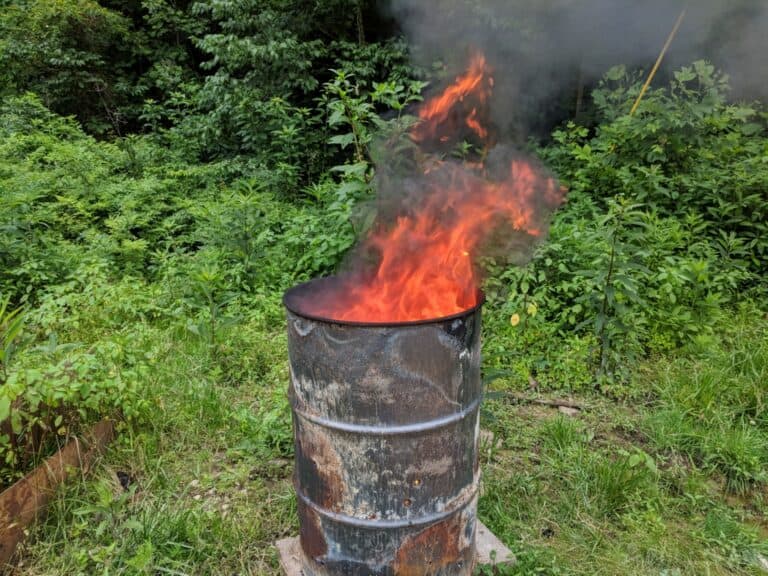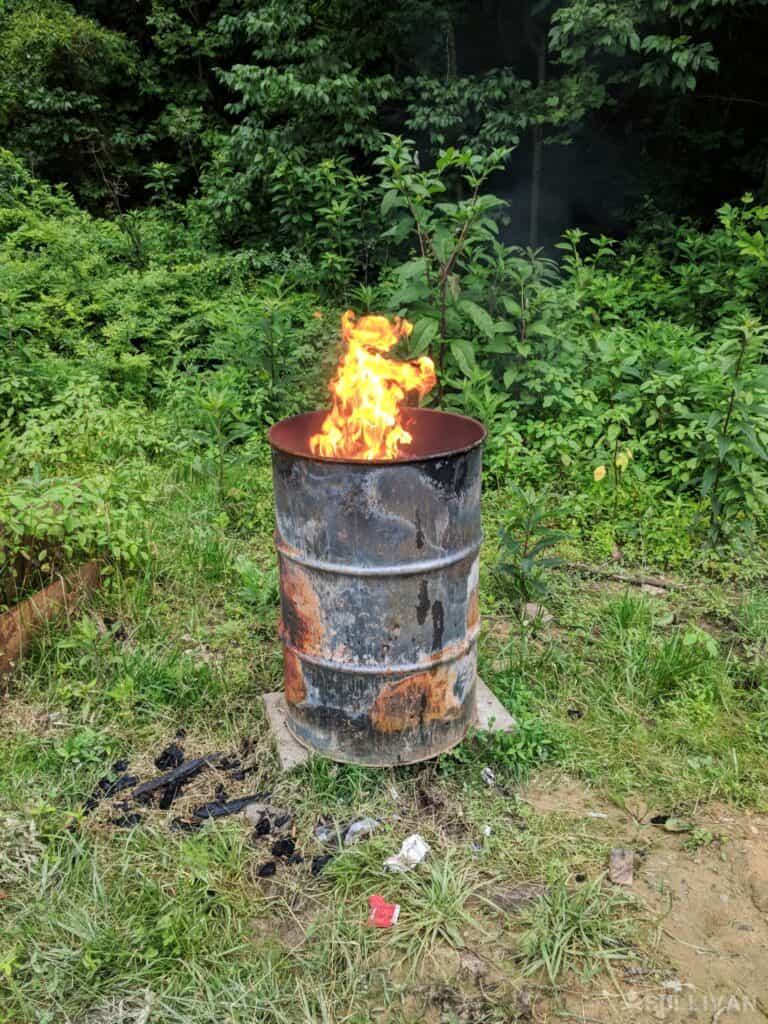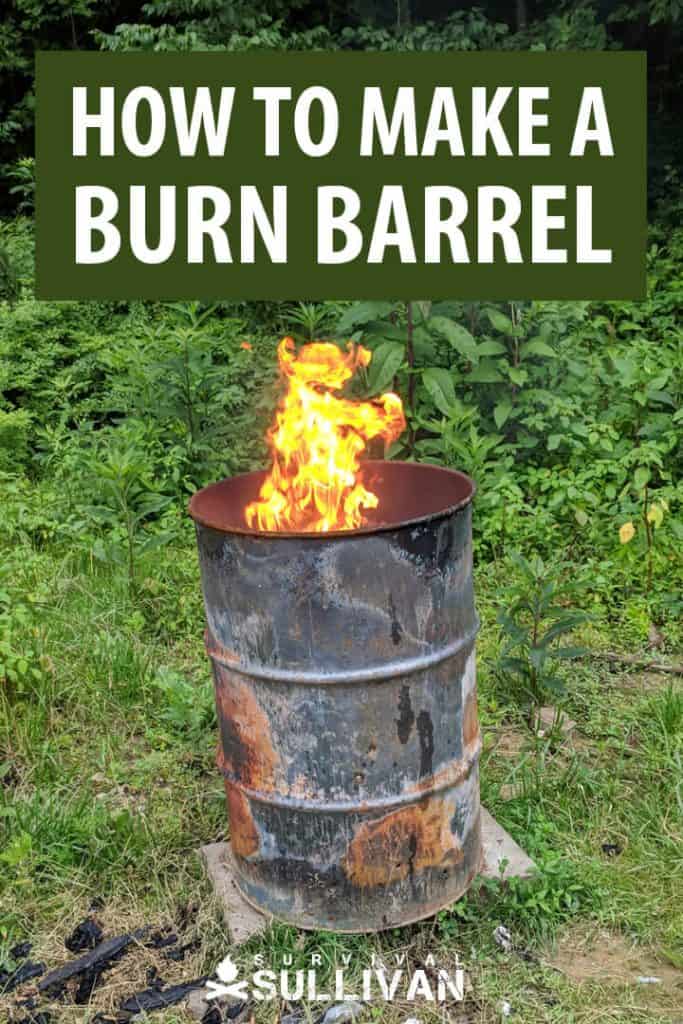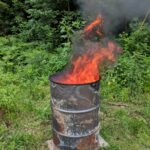Growing up country, burn barrels area part of our way of life. Not all preppers spent their childhoods running up and down dirt roads in their bare feet and playing in the woods. But many preppers and self-reliant folks need to figure out ways to safely dispose of trash, and a burn barrel is a quick and easy one.

What Exactly Is a Burn Barrel?
A burn barrel is nothing more than a re-purposed metal barrel with some holes in it that’s used to incinerate trash such as cardboard boxes, wood, cotton clothes, and more.
Safety Precautions
While setting up a burn barrel is not a complicated process, folks with no background in how they work could easily see a simple burning of a bag of trash turn into a tragic situation.
Brush fires are one of the most dangerous types of flames a firefighter could battle. It constantly garners fuel from both natural and man-made fuel, and shifts direction quickly due to only a slight change in the wind.
Speaking of which, it’s not unusual for “burn bans” to be in effect during hot and dry seasons. Make sure you know the local laws and pay attention to emergency ban alerts in your area before filling the burn barrel with trash and setting it on fire.
Location, Location, Location
Setting up a burn barrel is only part of the equation. You must also take into consideration barrel placement, weather conditions and the type of material going into the 55-gallon drum. Burn barrels aren’t dangerous as long as they are set up and used properly – and local laws are followed to avoid stiff fines or arrest.
Never, ever place a burn barrel near your home, garage, barn, or storage building. If a brush fire does occur, all of the gasoline, diesel fuel, and propane stored in a garage or shed will cause it to spread more rapidly or risk a potential explosion happening.
A burn barrel should be placed on solid ground that is free of grass or debris either around or beneath it. The 55-gallon drum will be placed upon cinder blocks, the area under it and around it still needs to be cut down to the dirt and raked to remove any potential fuel that hot embers could ignite.
When I was the editor of our county newspaper, I used to go onto a lot of fire calls…
Over the course of those years, and since listening to my firefighter husband’s radio, I learned first hand how quickly poor barrel placement, weather, a worn out barrel, and leaving the burning items unattended can cause a raging brush fire that will take out a nearby home – and more.
What Is A Burn Barrel?
A typical burn barrel is a 55-gallon open metal drum that has been slightly modified. The diameter of the most commonly used burn barrels is about 33.5 inches tall and 22.5 inches wide.
If buying a used metal drum (which often happens) it is essential to know what the barrel had housed previously. If toxic or highly flammable materials were stored inside, using the drum as a burn barrel could be extremely dangerous.

Burn Barrel Covers
Many folks do not cover their burn barrels, but doing so it a really great idea. A tiny ember that blows out of the 55-gallon drum, even hours after the trash has been burnt, can start a fire if it lands on dry debris or flammable materials.
To make a cover for a burn barrel, simply cut a piece of hardware cloth large enough to fit over the mouth of the barrel.
Bend it down the center to crease it a bit so it stays in place. If it is too windy for the hardware cloth to remain in place without tying it to a hole you drill in the barrel, it is too windy to be burning trash.
You can place a piece of metal sheeting over the mouth of the barrel to keep rain, snow, and ice out when it is not in use – or simply flip the burn barrel over and put a cinder block on top.
If you opt to make a downtime barrel cover, drill a hole in the edge of each side, as well as the corresponding sides of the barrel, and attach it with a bit of chain, or tie down straps that can be easily removed when needed.
Steps To Making A Burn Barrel
Equipment
- 1 55-gallon drum barrel
- 2 cinder blocks
- 1 Power drill with a 1 ½ bit
Instructions
- Drill between four and six ½ holes in the bottom of the barrel to create additional airflow. This will improve rain drainage, but mandates occasional scooping out of ashes around the base of the burn barrel.
- It doesn't hurt to add more holes up the side (but they are not necessary) unless you add so many the metal drum becomes unstable.
- Place two cinder blocks in the desired barrel placement spot.
- Sit the 55-gallon drum on top of the cinder blocks.
- Use tin snips or a steel saw to cut the hardware cloth and metal sheeting covers to fit – if you are using them.
How To Use My Burn Barrel
Using your burn barrel is pretty easy:
- Make sure your barrel is set correctly on the cinder blocks, and away from any buildings or trees.
- Load your barrel with the heaviest debris first.
- Add smaller pieces of junk you want to burn. Your barrel should never be more than halfway full.
- Light up a match and throw it into the barrel.
- Place the metal grate / hardware cloth covering on top. Be careful when you remove it not to burn yourself!
Burn Barrel Tips
Burn only one or two bags of trash at a time. If you overload, the burn barrel embers will blow out of the 55-gallon drum far easier. Also, if too much trash is placed in the barrel at a time, it will smolder but not burn. This can cause more of a safety concern if the barrel is left unattended, because you think the rubbish did not catch.
The ashes left in the bottom of the barrel or beneath it will need to be scooped up or they will blow everywhere. Depending upon what you burned in the barrel, the ashes can be placed in the compost pile.
Always remove unburnt trash from the burn barrel.
Do not put trash inside the 55-gallon drum before you are ready to set it on fire. The rubbish will attract unwanted predators and rodents to your survival homestead.
Sooner or later, the metal burn barrel will rust. There’s simply no way to prevent rust from developing on metal left outside and exposed to the elements. Plan for this eventuality and have another 55-gallon drum ready to be turned into a burn barrel.
What You Shouldn’t Burn In A Metal Barrel
- ❌ Food scraps – these are best tossed into your compost pile to make quality compost for your garden.
- ❌ Non-combustible items, like glass, lightbulbs, and aerosol cans.
- ❌ Hazardous waste
- ❌ Diseased plants or trees – the spores can fly out of the barrel and spread their fungus.
- ❌ Plastic
- ❌ Rubber
Burn Barrels FAQ
Since folks tend to leave their burn barrels outside at all times, they’ll rust eventually. Use a metal lid to cover it, a larger plastic sheet to cover it whole, or place it to a dry location when not in use. Alternatively, you can use a stainless steel barrel.
Yes, you’ll need 4 to 6 holes at the bottom to allow for rainwater drainage, and a few more on the sides for airflow during the burning process (ventilation holes).
You can find plenty of burn barrels online (Amazon, eBay), or offline at Walmart or Tractor Supply.


Tara Dodrill is a homesteading and survival journalist and author. She lives on a small ranch with her family in Appalachia. She has been both a host and frequent guest on preparedness radio shows. In addition to the publication of her first book, ‘Power Grid Down: How to Prepare, Survive, and Thrive after the Lights go Out’, Dodrill also travels to offer prepping tips and hands-on training and survival camps and expos.


Gary P again. Remind the folks…if you are burning anything in a SHTF Situation, SOMEBODY could smell you many miles away and just follow the smell. If you have ANYTHING to burn, then you have something to EAT, THROW AWAY, ETC. which means you have something to STEAL/TAKE!! Be careful.
When I was a kid in the late seventies and eighties, a burn barrel was a normal thing to have in the backyard. It was second nature to burn combustible garbage and to scoop out the ash. As the laws have changed over the last thirty years, burn barrels have been vanishing across the country. However, once a SHTF scenario arises, burn barrels would make a huge comeback. This article emphasizes the need to become knowledgable on how to correctly construct and utilize a burn barrel.